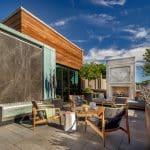
This project earned Mullin a Gold Award for Interior Installation in the 2023 Awards of Excellence.
Since its opening in 1990, the Audubon Aquarium in New Orleans, Louisiana, has attracted millions of visitors to see unique marine life and tropical ecosystems. In recent years, the aquarium has undergone renovations to improve the facility.
One focus area for the project was a conservatory filled with tropical plantings and fish exhibits. Many of the trees in this area had become overgrown, and other problems were beginning to arise. Hence, the aquarium worked with Mullin, based in St. Rose, Louisiana, to clean up the space and create a tropical forest that mirrors the Amazon.

Kurt Garris, the construction division manager at Mullin, shares a few details.
“The plantings were overgrowing the spaces, and the planters were leaking,” Garris says. “The central part of the project was to reduce the vine plantings that were taking over and remove all the soil from the planters to fix leaks. We also removed large trees and palms that were outgrowing their space and pushing on the interior roof. They wanted to mimic the lushness of the rainforest and try to utilize some large trees from South America that would remain smaller and not overtake the space. We also worked with the aquarium’s husbandry and veterinary staff to select plants that weren’t toxic to the free-flying birds inside the exhibit.”
Another factor was the location of the plants, as many of them are 20-30 feet off the ground. To navigate the space safely, the team used climbing ropes while removing debris, but they also had to prevent debris from falling into the fish tanks below them.
“We devised a mesh tarp system that allowed debris to not fall in the water but to slide down the tarps onto the concrete in front of the exhibits,” Garris says.
Additionally, the team installed 400 plants throughout the conservatory, which meant utilizing hidden beams and points of access to transport plants in the upper areas of the landscape. They used ropes and pullies for larger plants to move the material into the right places. Irrigation was another piece of the puzzle.

“We utilized drip irrigation, PEX tubing, and poly pipe to run flexible lines throughout the exhibit,” Garris says. “We had to get creative and run lines through faux logs and hide lines within plants, so you won’t see them.”
Many forms of wildlife were present in the exhibit during this project, so everyone had to be mindful of their whereabouts.
“All of this work was being done while the native Amazon birds were still free flying in the exhibit,” Garris says. “We would have to make sure no birds would be in the way while we were working, and most of them sought refuge in other areas of the exhibit.”
Each day, Mullin met with the aquarium staff to coordinate timing and decide how they work to avoid interfering with routine aquarium tasks, like feeding the animals.

“On certain days, we’d have to demo areas and stage debris in the exhibit while they fed other animals or did veterinary checks,” Garris says. “Once they were done, we could load it out of the building. There was another time we had to coordinate bringing in additional plant materials and having it staged since the veterinary staff would be removing the penguins from the exhibit, so we had to walk by to get in and out. The penguins had to be relocated for a few days while some work was being done on their exhibit, and we didn’t want to alarm them.”
While the project was complex, the results were a success for both Mullin and the aquarium.
“The client loved working with us, and we did more projects for them at other properties,” Garris says. “It’s rewarding to come together as a team and transform a poorly maintained and overgrown landscape into a newly landscaped area with more suitable plants that the public can enjoy for years to come.”
Interested in participating in the Awards of Excellence? Enter your projects by July 29, 2024.
This article was published in the May/June issue of the magazine. To read more stories from The Edge magazine, click here to subscribe to the digital edition.




